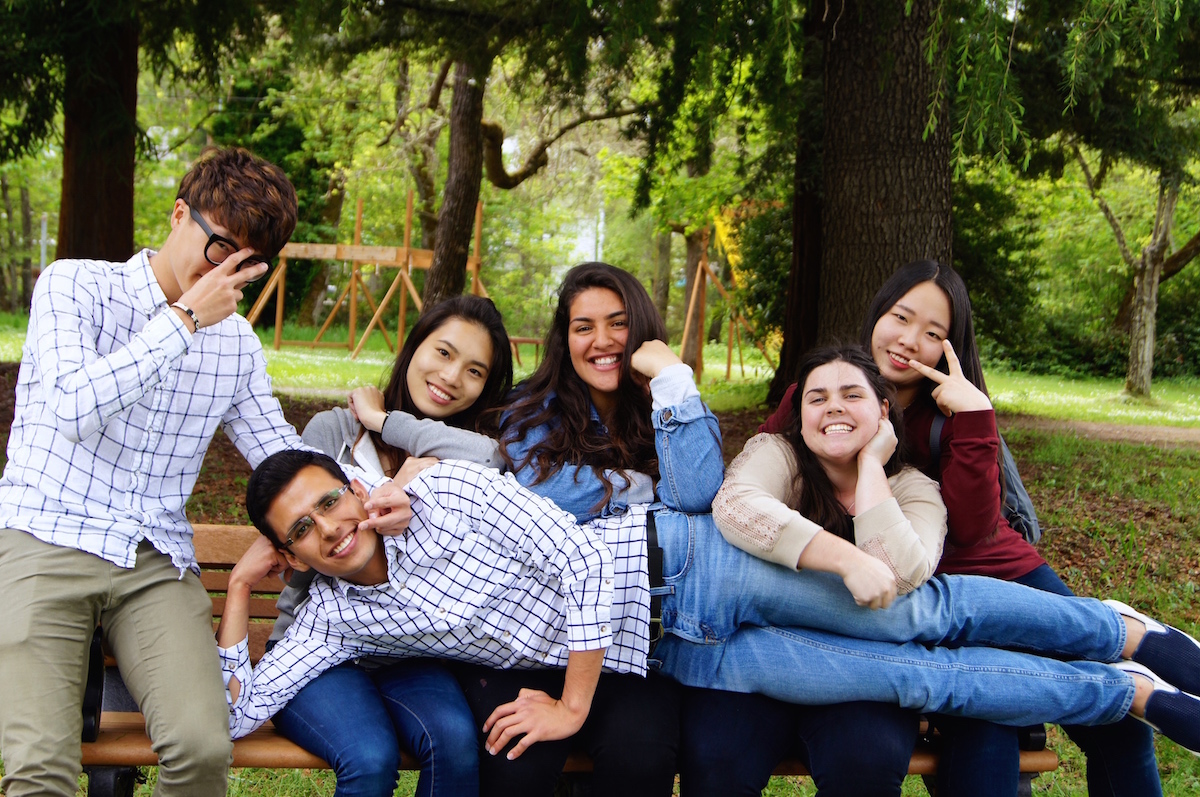What is Culture Shock?
by admin
Whether you are from a different country or simply a different town, culture shock affects international and domestic students alike in different ways and to various degrees.
What is Culture?
Culture includes such things as social behaviors (Ex. people’s attitudes, gestures, tone of voice, etc.), language, food, dress, etiquette, customs, beliefs, and values. Culture can also be seen and felt in the simple differences of attitudes, feelings, and ideas from one place to another. Ex. Going to a formal dinner event for a charity as opposed to a picnic lunch at a music festival. Many aspects of culture are understood, unspoken norms, which are learned from growing up in the culture.

What is Culture Shock?
People experience culture shock when they are separated from their culture, daily routines, and environments. It is normal for students to experience culture shock when they are in a new country and/or school. All at once, students are having to process through cultural differences and several life changes. If students begin to feel anxious, resentful, tired, disoriented, or isolated, they may be experiencing culture shock. Culture shock is an adjustment that takes place in four stages. It is helpful to understand and identify the symptoms and stages of culture shock so that students can work through them and fully enjoy their school experience.
The Four Stages of Culture Shock
1. INITIAL EUPHORIA / THE HONEYMOON STAGE
For the first week or month of school, students are excited about their new surroundings, friends, and experiences. They see similarities between their home culture and new culture. They view the differences in culture as fascinating and fun.
2. IRRITATION AND HOSTILITY / THE NEGOTIATION STAGE
After some time, the excitement begins to fade. Students may begin to feel overwhelmed and irritated by all the changes. They may start to focus more on the differences in the culture rather than the similarities. They may become negative, critical, and/or resentful towards their new environment. Students may begin to sleep or cry a lot, call/ Skype home frequently, or isolate themselves. They may also start spending a majority of their time with students from their own culture who speak their language.
3. GRADUAL UNDERSTANDING / THE ADJUSTMENT STAGE
Students begin to gain a better understanding of their new culture, its differences and the reasons for them. They now feel more comfortable and the cultural norms are becoming natural to them. Students are more relaxed, positive, and accepting. They begin to show interest in their new culture once again and want to learn more and fit in.
4. ADAPTION OR BICULTURALISM/ THE MASTERY STAGE
Students experience breakthrough and feel at home in their new culture. They understand the culture and now feel comfortable in it. They enjoy their new routines, friends, activities, and daily lives. Areas of the culture in which they were unsure of how to act now come naturally. There will always be parts of their old culture that they will miss; however, they have come to accept and adapt to their new lives. They may even find that they prefer aspects of their new culture to their old one.
It is important to remember that experiencing culture shock is natural and normal. The intensity and length of time it takes to work through culture shock varies from student to student. It is not caused by a single event, but “by encountering different ways of doing things, being cut off from cultural cues, having your own cultural values brought into question, feeling that rules are not adequately explained, and being expected to function with maximum skill without adequate knowledge of the rules,” (the University of North Carolina). Culture shock only lasts for a certain amount of time and can reoccur. Students themselves play a part in determining how long they experience culture shock and should not be afraid to talk to others about it or ask for help.
> Stay tuned for Canyonville Christian Academy’s Tips on Overcoming Culture Shock!
What is Culture Shock?
by admin
Whether you are from a different country or simply a different town, culture shock affects international and domestic students alike in different ways and to various degrees.
What is Culture?
Culture includes such things as social behaviors (Ex. people’s attitudes, gestures, tone of voice, etc.), language, food, dress, etiquette, customs, beliefs, and values. Culture can also be seen and felt in the simple differences of attitudes, feelings, and ideas from one place to another. Ex. Going to a formal dinner event for a charity as opposed to a picnic lunch at a music festival. Many aspects of culture are understood, unspoken norms, which are learned from growing up in the culture.

What is Culture Shock?
People experience culture shock when they are separated from their culture, daily routines, and environments. It is normal for students to experience culture shock when they are in a new country and/or school. All at once, students are having to process through cultural differences and several life changes. If students begin to feel anxious, resentful, tired, disoriented, or isolated, they may be experiencing culture shock. Culture shock is an adjustment that takes place in four stages. It is helpful to understand and identify the symptoms and stages of culture shock so that students can work through them and fully enjoy their school experience.
The Four Stages of Culture Shock
1. INITIAL EUPHORIA / THE HONEYMOON STAGE
For the first week or month of school, students are excited about their new surroundings, friends, and experiences. They see similarities between their home culture and new culture. They view the differences in culture as fascinating and fun.
2. IRRITATION AND HOSTILITY / THE NEGOTIATION STAGE
After some time, the excitement begins to fade. Students may begin to feel overwhelmed and irritated by all the changes. They may start to focus more on the differences in the culture rather than the similarities. They may become negative, critical, and/or resentful towards their new environment. Students may begin to sleep or cry a lot, call/ Skype home frequently, or isolate themselves. They may also start spending a majority of their time with students from their own culture who speak their language.
3. GRADUAL UNDERSTANDING / THE ADJUSTMENT STAGE
Students begin to gain a better understanding of their new culture, its differences and the reasons for them. They now feel more comfortable and the cultural norms are becoming natural to them. Students are more relaxed, positive, and accepting. They begin to show interest in their new culture once again and want to learn more and fit in.
4. ADAPTION OR BICULTURALISM/ THE MASTERY STAGE
Students experience breakthrough and feel at home in their new culture. They understand the culture and now feel comfortable in it. They enjoy their new routines, friends, activities, and daily lives. Areas of the culture in which they were unsure of how to act now come naturally. There will always be parts of their old culture that they will miss; however, they have come to accept and adapt to their new lives. They may even find that they prefer aspects of their new culture to their old one.
It is important to remember that experiencing culture shock is natural and normal. The intensity and length of time it takes to work through culture shock varies from student to student. It is not caused by a single event, but “by encountering different ways of doing things, being cut off from cultural cues, having your own cultural values brought into question, feeling that rules are not adequately explained, and being expected to function with maximum skill without adequate knowledge of the rules,” (the University of North Carolina). Culture shock only lasts for a certain amount of time and can reoccur. Students themselves play a part in determining how long they experience culture shock and should not be afraid to talk to others about it or ask for help.
> Stay tuned for Canyonville Christian Academy’s Tips on Overcoming Culture Shock!
What is Culture Shock?
by admin
Whether you are from a different country or simply a different town, culture shock affects international and domestic students alike in different ways and to various degrees.
What is Culture?
Culture includes such things as social behaviors (Ex. people’s attitudes, gestures, tone of voice, etc.), language, food, dress, etiquette, customs, beliefs, and values. Culture can also be seen and felt in the simple differences of attitudes, feelings, and ideas from one place to another. Ex. Going to a formal dinner event for a charity as opposed to a picnic lunch at a music festival. Many aspects of culture are understood, unspoken norms, which are learned from growing up in the culture.

What is Culture Shock?
People experience culture shock when they are separated from their culture, daily routines, and environments. It is normal for students to experience culture shock when they are in a new country and/or school. All at once, students are having to process through cultural differences and several life changes. If students begin to feel anxious, resentful, tired, disoriented, or isolated, they may be experiencing culture shock. Culture shock is an adjustment that takes place in four stages. It is helpful to understand and identify the symptoms and stages of culture shock so that students can work through them and fully enjoy their school experience.
The Four Stages of Culture Shock
1. INITIAL EUPHORIA / THE HONEYMOON STAGE
For the first week or month of school, students are excited about their new surroundings, friends, and experiences. They see similarities between their home culture and new culture. They view the differences in culture as fascinating and fun.
2. IRRITATION AND HOSTILITY / THE NEGOTIATION STAGE
After some time, the excitement begins to fade. Students may begin to feel overwhelmed and irritated by all the changes. They may start to focus more on the differences in the culture rather than the similarities. They may become negative, critical, and/or resentful towards their new environment. Students may begin to sleep or cry a lot, call/ Skype home frequently, or isolate themselves. They may also start spending a majority of their time with students from their own culture who speak their language.
3. GRADUAL UNDERSTANDING / THE ADJUSTMENT STAGE
Students begin to gain a better understanding of their new culture, its differences and the reasons for them. They now feel more comfortable and the cultural norms are becoming natural to them. Students are more relaxed, positive, and accepting. They begin to show interest in their new culture once again and want to learn more and fit in.
4. ADAPTION OR BICULTURALISM/ THE MASTERY STAGE
Students experience breakthrough and feel at home in their new culture. They understand the culture and now feel comfortable in it. They enjoy their new routines, friends, activities, and daily lives. Areas of the culture in which they were unsure of how to act now come naturally. There will always be parts of their old culture that they will miss; however, they have come to accept and adapt to their new lives. They may even find that they prefer aspects of their new culture to their old one.
It is important to remember that experiencing culture shock is natural and normal. The intensity and length of time it takes to work through culture shock varies from student to student. It is not caused by a single event, but “by encountering different ways of doing things, being cut off from cultural cues, having your own cultural values brought into question, feeling that rules are not adequately explained, and being expected to function with maximum skill without adequate knowledge of the rules,” (the University of North Carolina). Culture shock only lasts for a certain amount of time and can reoccur. Students themselves play a part in determining how long they experience culture shock and should not be afraid to talk to others about it or ask for help.
> Stay tuned for Canyonville Christian Academy’s Tips on Overcoming Culture Shock!
What is Culture Shock?
by admin
Whether you are from a different country or simply a different town, culture shock affects international and domestic students alike in different ways and to various degrees.
What is Culture?
Culture includes such things as social behaviors (Ex. people’s attitudes, gestures, tone of voice, etc.), language, food, dress, etiquette, customs, beliefs, and values. Culture can also be seen and felt in the simple differences of attitudes, feelings, and ideas from one place to another. Ex. Going to a formal dinner event for a charity as opposed to a picnic lunch at a music festival. Many aspects of culture are understood, unspoken norms, which are learned from growing up in the culture.

What is Culture Shock?
People experience culture shock when they are separated from their culture, daily routines, and environments. It is normal for students to experience culture shock when they are in a new country and/or school. All at once, students are having to process through cultural differences and several life changes. If students begin to feel anxious, resentful, tired, disoriented, or isolated, they may be experiencing culture shock. Culture shock is an adjustment that takes place in four stages. It is helpful to understand and identify the symptoms and stages of culture shock so that students can work through them and fully enjoy their school experience.
The Four Stages of Culture Shock
1. INITIAL EUPHORIA / THE HONEYMOON STAGE
For the first week or month of school, students are excited about their new surroundings, friends, and experiences. They see similarities between their home culture and new culture. They view the differences in culture as fascinating and fun.
2. IRRITATION AND HOSTILITY / THE NEGOTIATION STAGE
After some time, the excitement begins to fade. Students may begin to feel overwhelmed and irritated by all the changes. They may start to focus more on the differences in the culture rather than the similarities. They may become negative, critical, and/or resentful towards their new environment. Students may begin to sleep or cry a lot, call/ Skype home frequently, or isolate themselves. They may also start spending a majority of their time with students from their own culture who speak their language.
3. GRADUAL UNDERSTANDING / THE ADJUSTMENT STAGE
Students begin to gain a better understanding of their new culture, its differences and the reasons for them. They now feel more comfortable and the cultural norms are becoming natural to them. Students are more relaxed, positive, and accepting. They begin to show interest in their new culture once again and want to learn more and fit in.
4. ADAPTION OR BICULTURALISM/ THE MASTERY STAGE
Students experience breakthrough and feel at home in their new culture. They understand the culture and now feel comfortable in it. They enjoy their new routines, friends, activities, and daily lives. Areas of the culture in which they were unsure of how to act now come naturally. There will always be parts of their old culture that they will miss; however, they have come to accept and adapt to their new lives. They may even find that they prefer aspects of their new culture to their old one.
It is important to remember that experiencing culture shock is natural and normal. The intensity and length of time it takes to work through culture shock varies from student to student. It is not caused by a single event, but “by encountering different ways of doing things, being cut off from cultural cues, having your own cultural values brought into question, feeling that rules are not adequately explained, and being expected to function with maximum skill without adequate knowledge of the rules,” (the University of North Carolina). Culture shock only lasts for a certain amount of time and can reoccur. Students themselves play a part in determining how long they experience culture shock and should not be afraid to talk to others about it or ask for help.
> Stay tuned for Canyonville Christian Academy’s Tips on Overcoming Culture Shock!
What is Culture Shock?
by admin
Whether you are from a different country or simply a different town, culture shock affects international and domestic students alike in different ways and to various degrees.
What is Culture?
Culture includes such things as social behaviors (Ex. people’s attitudes, gestures, tone of voice, etc.), language, food, dress, etiquette, customs, beliefs, and values. Culture can also be seen and felt in the simple differences of attitudes, feelings, and ideas from one place to another. Ex. Going to a formal dinner event for a charity as opposed to a picnic lunch at a music festival. Many aspects of culture are understood, unspoken norms, which are learned from growing up in the culture.

What is Culture Shock?
People experience culture shock when they are separated from their culture, daily routines, and environments. It is normal for students to experience culture shock when they are in a new country and/or school. All at once, students are having to process through cultural differences and several life changes. If students begin to feel anxious, resentful, tired, disoriented, or isolated, they may be experiencing culture shock. Culture shock is an adjustment that takes place in four stages. It is helpful to understand and identify the symptoms and stages of culture shock so that students can work through them and fully enjoy their school experience.
The Four Stages of Culture Shock
1. INITIAL EUPHORIA / THE HONEYMOON STAGE
For the first week or month of school, students are excited about their new surroundings, friends, and experiences. They see similarities between their home culture and new culture. They view the differences in culture as fascinating and fun.
2. IRRITATION AND HOSTILITY / THE NEGOTIATION STAGE
After some time, the excitement begins to fade. Students may begin to feel overwhelmed and irritated by all the changes. They may start to focus more on the differences in the culture rather than the similarities. They may become negative, critical, and/or resentful towards their new environment. Students may begin to sleep or cry a lot, call/ Skype home frequently, or isolate themselves. They may also start spending a majority of their time with students from their own culture who speak their language.
3. GRADUAL UNDERSTANDING / THE ADJUSTMENT STAGE
Students begin to gain a better understanding of their new culture, its differences and the reasons for them. They now feel more comfortable and the cultural norms are becoming natural to them. Students are more relaxed, positive, and accepting. They begin to show interest in their new culture once again and want to learn more and fit in.
4. ADAPTION OR BICULTURALISM/ THE MASTERY STAGE
Students experience breakthrough and feel at home in their new culture. They understand the culture and now feel comfortable in it. They enjoy their new routines, friends, activities, and daily lives. Areas of the culture in which they were unsure of how to act now come naturally. There will always be parts of their old culture that they will miss; however, they have come to accept and adapt to their new lives. They may even find that they prefer aspects of their new culture to their old one.
It is important to remember that experiencing culture shock is natural and normal. The intensity and length of time it takes to work through culture shock varies from student to student. It is not caused by a single event, but “by encountering different ways of doing things, being cut off from cultural cues, having your own cultural values brought into question, feeling that rules are not adequately explained, and being expected to function with maximum skill without adequate knowledge of the rules,” (the University of North Carolina). Culture shock only lasts for a certain amount of time and can reoccur. Students themselves play a part in determining how long they experience culture shock and should not be afraid to talk to others about it or ask for help.
> Stay tuned for Canyonville Christian Academy’s Tips on Overcoming Culture Shock!
What is Culture Shock?
by admin
Whether you are from a different country or simply a different town, culture shock affects international and domestic students alike in different ways and to various degrees.
What is Culture?
Culture includes such things as social behaviors (Ex. people’s attitudes, gestures, tone of voice, etc.), language, food, dress, etiquette, customs, beliefs, and values. Culture can also be seen and felt in the simple differences of attitudes, feelings, and ideas from one place to another. Ex. Going to a formal dinner event for a charity as opposed to a picnic lunch at a music festival. Many aspects of culture are understood, unspoken norms, which are learned from growing up in the culture.

What is Culture Shock?
People experience culture shock when they are separated from their culture, daily routines, and environments. It is normal for students to experience culture shock when they are in a new country and/or school. All at once, students are having to process through cultural differences and several life changes. If students begin to feel anxious, resentful, tired, disoriented, or isolated, they may be experiencing culture shock. Culture shock is an adjustment that takes place in four stages. It is helpful to understand and identify the symptoms and stages of culture shock so that students can work through them and fully enjoy their school experience.
The Four Stages of Culture Shock
1. INITIAL EUPHORIA / THE HONEYMOON STAGE
For the first week or month of school, students are excited about their new surroundings, friends, and experiences. They see similarities between their home culture and new culture. They view the differences in culture as fascinating and fun.
2. IRRITATION AND HOSTILITY / THE NEGOTIATION STAGE
After some time, the excitement begins to fade. Students may begin to feel overwhelmed and irritated by all the changes. They may start to focus more on the differences in the culture rather than the similarities. They may become negative, critical, and/or resentful towards their new environment. Students may begin to sleep or cry a lot, call/ Skype home frequently, or isolate themselves. They may also start spending a majority of their time with students from their own culture who speak their language.
3. GRADUAL UNDERSTANDING / THE ADJUSTMENT STAGE
Students begin to gain a better understanding of their new culture, its differences and the reasons for them. They now feel more comfortable and the cultural norms are becoming natural to them. Students are more relaxed, positive, and accepting. They begin to show interest in their new culture once again and want to learn more and fit in.
4. ADAPTION OR BICULTURALISM/ THE MASTERY STAGE
Students experience breakthrough and feel at home in their new culture. They understand the culture and now feel comfortable in it. They enjoy their new routines, friends, activities, and daily lives. Areas of the culture in which they were unsure of how to act now come naturally. There will always be parts of their old culture that they will miss; however, they have come to accept and adapt to their new lives. They may even find that they prefer aspects of their new culture to their old one.
It is important to remember that experiencing culture shock is natural and normal. The intensity and length of time it takes to work through culture shock varies from student to student. It is not caused by a single event, but “by encountering different ways of doing things, being cut off from cultural cues, having your own cultural values brought into question, feeling that rules are not adequately explained, and being expected to function with maximum skill without adequate knowledge of the rules,” (the University of North Carolina). Culture shock only lasts for a certain amount of time and can reoccur. Students themselves play a part in determining how long they experience culture shock and should not be afraid to talk to others about it or ask for help.
> Stay tuned for Canyonville Christian Academy’s Tips on Overcoming Culture Shock!
What is Culture Shock?
by admin
Whether you are from a different country or simply a different town, culture shock affects international and domestic students alike in different ways and to various degrees.
What is Culture?
Culture includes such things as social behaviors (Ex. people’s attitudes, gestures, tone of voice, etc.), language, food, dress, etiquette, customs, beliefs, and values. Culture can also be seen and felt in the simple differences of attitudes, feelings, and ideas from one place to another. Ex. Going to a formal dinner event for a charity as opposed to a picnic lunch at a music festival. Many aspects of culture are understood, unspoken norms, which are learned from growing up in the culture.

What is Culture Shock?
People experience culture shock when they are separated from their culture, daily routines, and environments. It is normal for students to experience culture shock when they are in a new country and/or school. All at once, students are having to process through cultural differences and several life changes. If students begin to feel anxious, resentful, tired, disoriented, or isolated, they may be experiencing culture shock. Culture shock is an adjustment that takes place in four stages. It is helpful to understand and identify the symptoms and stages of culture shock so that students can work through them and fully enjoy their school experience.
The Four Stages of Culture Shock
1. INITIAL EUPHORIA / THE HONEYMOON STAGE
For the first week or month of school, students are excited about their new surroundings, friends, and experiences. They see similarities between their home culture and new culture. They view the differences in culture as fascinating and fun.
2. IRRITATION AND HOSTILITY / THE NEGOTIATION STAGE
After some time, the excitement begins to fade. Students may begin to feel overwhelmed and irritated by all the changes. They may start to focus more on the differences in the culture rather than the similarities. They may become negative, critical, and/or resentful towards their new environment. Students may begin to sleep or cry a lot, call/ Skype home frequently, or isolate themselves. They may also start spending a majority of their time with students from their own culture who speak their language.
3. GRADUAL UNDERSTANDING / THE ADJUSTMENT STAGE
Students begin to gain a better understanding of their new culture, its differences and the reasons for them. They now feel more comfortable and the cultural norms are becoming natural to them. Students are more relaxed, positive, and accepting. They begin to show interest in their new culture once again and want to learn more and fit in.
4. ADAPTION OR BICULTURALISM/ THE MASTERY STAGE
Students experience breakthrough and feel at home in their new culture. They understand the culture and now feel comfortable in it. They enjoy their new routines, friends, activities, and daily lives. Areas of the culture in which they were unsure of how to act now come naturally. There will always be parts of their old culture that they will miss; however, they have come to accept and adapt to their new lives. They may even find that they prefer aspects of their new culture to their old one.
It is important to remember that experiencing culture shock is natural and normal. The intensity and length of time it takes to work through culture shock varies from student to student. It is not caused by a single event, but “by encountering different ways of doing things, being cut off from cultural cues, having your own cultural values brought into question, feeling that rules are not adequately explained, and being expected to function with maximum skill without adequate knowledge of the rules,” (the University of North Carolina). Culture shock only lasts for a certain amount of time and can reoccur. Students themselves play a part in determining how long they experience culture shock and should not be afraid to talk to others about it or ask for help.
> Stay tuned for Canyonville Christian Academy’s Tips on Overcoming Culture Shock!
What is Culture Shock?







